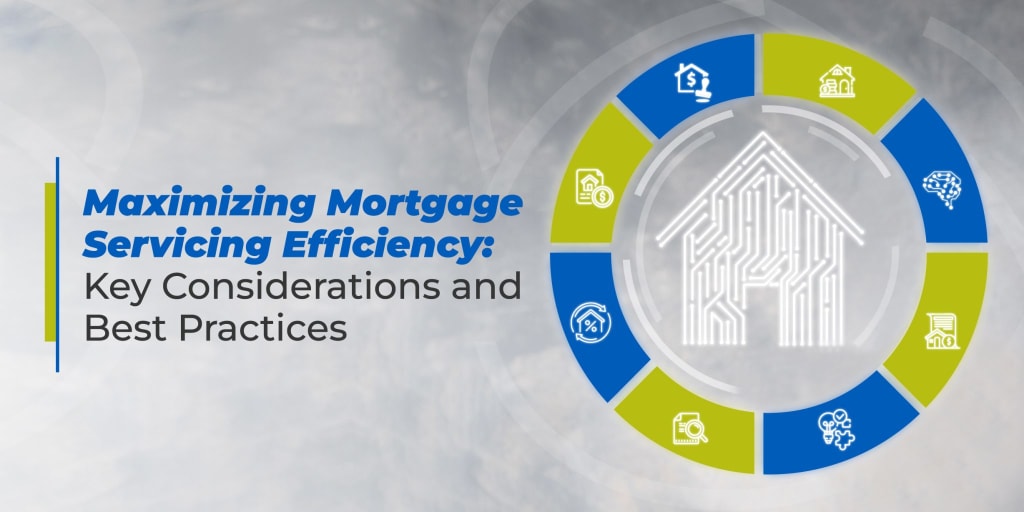Maximizing Mortgage Servicing Efficiency: Key Considerations and Best Practices
The secret to mortgage servicing efficiency isn’t just technology. Better mortgage performance metrics and end-to-end mortgage management is also needed.

As the cost of mortgage servicing increases, lenders need to come up with new ways to stay lean, cut costs, and make operations more efficient. Worryingly, mortgage servicing expenses have gone up by nearly 350% and 200% for non-performing and performing loans, respectively, in the last few decades, impacting your margins. That is why several providers have embraced digitization to achieve mortgage servicing efficiency. Lenders that have done so tend to leave legacy servicers behind.
The secret to mortgage servicing efficiency isn’t just more technology. There also have to be better mortgage performance metrics that can actually measure if you are reaching your targets. There also has to be a culture of end-to-end mortgage management so that the servicing workflow isn’t just a broken part of the value chain.
Why is Mortgage Servicing Efficiency an Industry Pain Point? Key Considerations in 2023
There are several reasons why mortgage servicing efficiency (or rather the lack of it) has reached a tipping point. Between 2019 and 2021 alone, the cost to service a loan has increased by over 9%, of which most of the expenses arise from corporate and administrative overheads. Importantly, the average number of loans serviced by a single employee reduced from 900 to 723.
It is well known that the mortgage industry is struggling with an aging workforce, which makes it difficult to stay productive in the face of a volatile and ever-changing market environment. Also, new regulations and geopolitical factors have increased the pressure on servicers to stay compliant. All of this leads to a protracted servicing experience and also the need to up your headcount.
Another reason why servicing efficiency is less than optimal is that servicers are not measuring the right metrics. Traditionally, lenders have relied on KPIs like average talk time, calls per agent, call waiting time, etc., to measure mortgage servicing efficiency. But these KPIs cannot capture the real picture and only depict the operational output of your contact center.
Instead, mortgage performance metrics like real-time monitoring of payment slippage and live dashboards showing delinquency rates are better aligned with your real industry needs.
Overhiring in bullish periods is another common cause for the dip in mortgage servicing efficiency. When lenders quickly increase their headcount at a time of high demand and optimistic economic conditions, they risk struggling with bloat when interest rates rise, origination volumes dip, and the compliance climate becomes more difficult. That is exactly what is happening now.
4 Best Practices for Maximizing Servicing Efficiency
To improve employee productivity and the efficiency of a typical mortgage servicing pipeline, you need to follow four best practices:
1. Practice intelligent staffing
A common mistake that makes mortgage process improvement difficult is hasty decisions around staffing. Faced with thinning margins, lenders try to outsource their in-house servicing practices overnight; or, some try to build an in-house function to quickly reduce outsourcing costs. Both approaches are set up for failure if they are not well thought out in advance.
Instead, organizations need to carefully assess demand and staffing patterns and build credible future projections. Based on this, you can outsource the most expensive and effort-intensive parts of your servicing function to an offshore partner in a best-cost location. Your outsourcing partner must be extremely agile and ready to cope with varying servicing volumes as part of the SLAs.
2. Start by breaking down silos
Reacting to narrow margins, mortgage servicers often look at stopgap solutions like replacing the entire system with an all-in-one digital tool. In reality, this rarely brings about genuine mortgage process improvements, as you still have a broken backend, siloed processes, and staff without digital literacy.
That’s why the first step to achieving long-term mortgage servicing efficiency is to break down silos — data silos that lead to duplication, skill silos that make staff redundant, as well as infrastructure silos that make connected and automated workflows next to impossible.
3. Pay special attention to delinquency servicing
Delinquent loans and mortgages at risk of default often consume the most amount of your resources. If your default servicing pipeline is efficient, then overall mortgage servicing efficiency is only a few steps away. To achieve this, you need to establish a seamless channel of communication with borrowers so that everyone is on the same page. You also need powerful data analytics that flags default risk before it is too late. That is why it is also important to monitor the right mortgage performance metrics in order to boost efficiency.
4. Give employees the tools for productivity
Unproductive employees can drastically bring down your servicing efficiency or make errors that lead to non-compliance. There are several ways in which you can increase the number of loans serviced per employee:
Invest in automation tools like document management systems and chatbots that free workers from mundane tasks.
Modernize communication channels so that employees receive the relevant alerts and action points on time.
Centralize your data repositories so employees can retrieve the correct information faster.
Train servicing officers on the new workflows and servicing best practices, particularly for default servicing.
The Right Partner Can Make All the Difference
Ever since the economic crisis of 2008, the servicing industry has been unpredictable and at odds with the continued bid for mortgage servicing efficiency. A partner conversant with industry knowledge, as well as technical expertise, can help you navigate these complexities. This is particularly important when interests are rising, which makes efficiency more important than ever before. At Nexval, our team of 1000+ subject matter experts delivers AI and cloud-based solutions that maximize efficiency while reducing your in-house costs.





Comments
There are no comments for this story
Be the first to respond and start the conversation.